Archive for ‘General’ Category
Paper Doll Writes Between the Raindrops: Waterproof Notebooks
Paper Doll knows you’re keeping track of a lot of information. Chances are good that you use a digital device for jotting down notes on the run. Digital is dandy…except in a downpour. If it’s raining or snowing, a non-digital alternative is often preferable.
That said, paper isn’t always the best way to deal with the problem, either. Rain. Fog. Snow. Humidity. All of these make it pretty difficult to organize your thoughts without ink bleeding through a mess of soggy papers. And if you’re the sort to send an assignment notebook through the washing machine, or have ever found yourself with a squishy pile of drenched notes after righting an overturned kayak, you know that water and paper are not the best of buddies.
Happily, there’s a nifty third option — one that avoids shorted out digital devices as well as soggy papers. Waterproof notebooks!
WATERPROOF SOLUTIONS FOR WATERLOGGED WRITERS
Do you scoff? Do you wonder who really needs such a thing? Waterproof notebooks are stellar options for:
- Private detectives — especially of the film noir variety, as it’s always drizzling in those stakeout scenes
- Military personnel, police officers, and firefighters
- Poolside novelists — when you get the burst of inspiration in the middle of doing the butterfly, can you really wait until you’ve completely dried off?
- Sailors, boaters, fishermen, and lobstermen (and women, of course) — because you really don’t want to risk someone yelling, “iPad overboard!”
- Shower sages — so you don’t forget those notions that come to you mid-shampoo
- Coaches, scorekeepers, golfers and other athletes — because keeping track of stats during outdoor sporting events often means keeping dry notes, even if you can’t keep a dry eye when your team is losing
- Outdoorsy adventurers, campers, and divers — in other words, people who are the exact opposite of Paper Doll, Paper Mommy and our ilk
- Bird-watchers — who don’t seem so bothered by morning mists or summer showers, but whose disposition sours at the thought of losing data on a Wilson’s Warbler
- Agricultural workers
- Geological surveyors
- Veterinarians and vet students specializing in farm, zoo and other large animals
- Engineers and contractors working on outdoor projects
- Seattle residents and the cast and crew of Portlandia
- All the rest of us who might need to keep track of survival information during hurricanes, floods, and other inclement weather
Luckily, there’s no dearth of alternatives in the waterproof notebook market.
THE OPTIONS

Rite in the Rain makes a big splash as a major player in the field of waterproof writing. The All-Weather Notebooks evoke the sense of a bright yellow rain slicker and puddle-jumping boots.

The pages are particularly heavy-duty, tear-resistant and durable — a little humidity, coffee or sleet won’t do them in. They come in two styles: weatherproof and truly waterproof, and it is advised to use waterproof pens with Rite in the Rain notebooks.
Rite in the Rain weatherproof notebooks all include durable polyethylene covers and come in a wide array of styles, including:
Shirt Pocket Notepad — 3″ x 5″, 50 sheets, top-spiral, with a 1/4″ grid pattern. Also available with a buff or green cover — but isn’t the yellow spiffier?
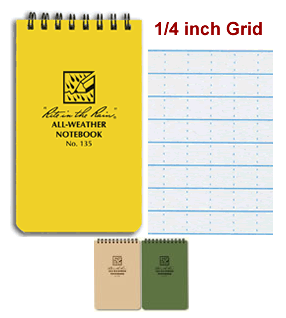
Hip Pocket Notepad — 4″ x 6″, 50 pages, top spiral, with a 1/4″ grid, and also available with the buff or green covers
Reporter’s Notebook — 4″ x 8″, 50 sheets, 1/4″ ruled
Mini Side Spiral Notebook — 3 1/4″ x 5″, 50 sheets, 1/4″ ruled
Small Side Spiral Notebook — 4 5/8″ x 4″, 32 sheets, ruled or grid pattern
Large Side Spiral Notebook — 8 /12″ x 11″, 42 sheets, ruled or grid pattern, rigid back cover for support
All-Weather Sketch Book — 8 /12″ x 11″, 42 sheets, blank, with a top spiral
Other intriguing specialty notebooks include a Beef Calving Record Book, a Fire Investigation Field Book and a Job Hazard Analysis notebook.
Rite in the Rain Field Books have weatherproof paper and a “fabrikoid” hardbound cover. Each 80 sheet notebook is 7 1/2″ x 4 5/8″ and comes in a wide variety of styles, including universal, field and birder journals, as well as environmental and geology field books, each with its own unique style of ruled lines and grids.
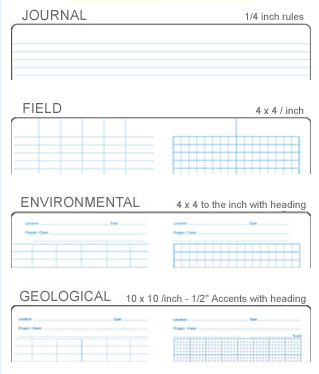
For those who are in over the heads — literally — Rite in the Rain makes DuraRite notebooks for use in extreme weather conditions and even under water. They aren’t as fashion-forward as their bright yellow cohorts, but the DuraRite Shirt Pocket, Hip Pocket and Side Spiral notebooks use an entirely waterproof synthetic paper to ensure the safety of creative and scientific endeavors.
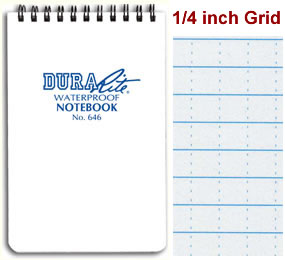
Rite in the Rain’s products retail for $4 to $20. For slightly more, customized versions are available — just choose your page patterns and preferred colors for covers, cover inks, paper and interior text.
Of course, Paper Doll would be a wet blanket if she didn’t provide a few spiffy wet-weather alternatives.
![]()
Emergency Zone, whose focus is survival and emergency kits and tools, has an All Weather Memo Pad that comes in a flashy red top-spiral assignment notebook.
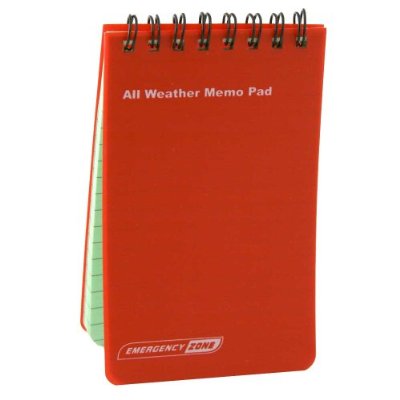
Unlike the Rite in the Rain products, for which weatherproof/waterproof pens are suggested, pencils also work fine with the Emergency Zone All-Weather Memo Pad. Retailing from $3 to $7, it is waterproof and suitable for putting in a Grab & Go bag. No information regarding the number of pages or dimensions was available from the company.

Ritchie Navigation’s Wet Notes are completely waterproof 4 1/2″ by 7 1/4″ pocket notebooks with hard yellow plastic covers over the wide white interior side-spiral binding.
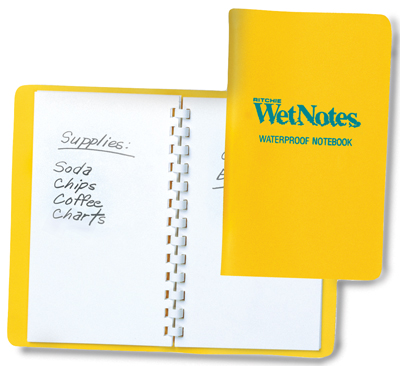
The 45-page notebook lies flat when open and comes with a soft lead pencil. The compass company’s products can be found at marine retailers nationwide. Ritchie also makes a 40-page 3″ x 5″ Wet Notes top-spiral notebook with a similar yellow plastic cover.

The Nalgene Waterproof PolyPaper Notebook is a bit of a conundrum. Scientists likely appreciate Nalgene’s 100-sheet Polyolefin waterproof notebooks for their exceptional durability, water- and chemical-resistance and smudge-proof performance under harsh field conditions.
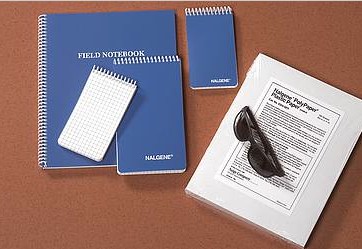
The 4 x 4 gridded paper cannot be used with pencils, but accepts a wide variety of inks, including gels, technical markers and ballpoints. Pages are numbered 1-96, with title and Table of Contents pages at the front. The paper can actually be washed and dried flat, like favorite sweaters!
However, the mystifyingly high price tag of $70.80 per notebook makes one wonder if one has swallowed too much swamp water. Certain that Lab Safety Supply had made a typo, I checked Forestry Suppliers, Inc., only to find their prices merely $2 lower, and Ben Meadow’s forestry suppliers had the same pricing as Lab Safety. Casebound hard-cover Nalgene PolyPaper notebooks are similarly priced at Amazon.
Either I’m missing something vital, or the accounting departments of various university labs are going to erect a monument to Paper Doll once this post goes viral. (Readers, you do intend to make this post go viral, don’t you?)

Wiley’s Waterproof Notebook will do the job, but the water-themed bubbly blue cover may be a little too cute and on-the-nose for some (like our Sam Spade wannabes). It retails for about $7.95 for 64 spiral-bound pages, and a pencil, rather than a waterproof pen, is recommended.
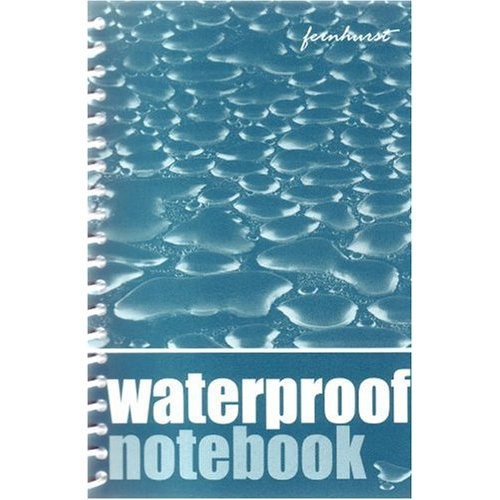
Unfortunately, the exact measurements were not available from the company or their retail outlets. However, if you teach sailing, camping, outdoor biology labs, or other classes where adverse weather is an issue, you can request an evaluation copy to see if it would be suitable for your students’ needs.
INTERNATIONAL WATERS
International readers, you haven’t been forgotten.
![]()
The indelicately-named Suck UK is both a product design company and purveyor of odd but enchanting gifts and accessories for the home. I’m particularly a fan of their organizer-friendly products like Peel & Stick postcards and magnetic tea towels.
Suck UK’s Waterproof Notebook has a simple black cover, standard book binding, 100% waterproof paper and is designed to be used with the enclosed graphite pencil.
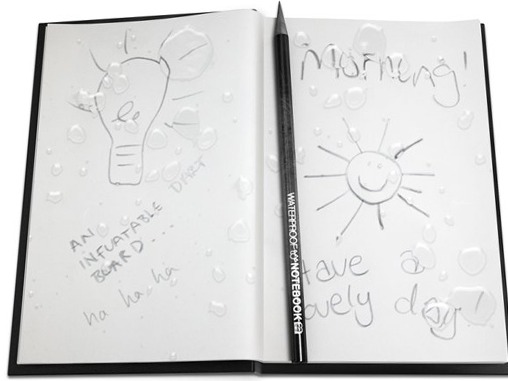
This notebook goes for 8.95 through the UK site, but Suck UK’s delightful products can also be purchased stateside at various sites, including Kris & Company and Ritz Sisters.

Australian readers can pick up Markrite All-Weather hard-cover 80-sheet notebooks, which are sewn with “rot-proof” thread and bound in durable casemade (i.e., turned edge) PVC covers. The soft-cover books are spiral-bound at the top or side, with polypropylene covers and 50 sheets of waterproof, tear-resistant, high rag content paper.
In addition to standard waterproof notebooks, Markrite also makes diving log books, bird-watching books (printed with detailed precision for tracking observation method, strata, and macro and micro habitat detail) and pocket-sized books.

Stationer and printer Flavell Creative Images of Scotland not only purveys Waterproof Tough Notes in multiple sizes (including A4, A5, and A6), but can also print whatever your business, club, group or family needs for any of a ridiculously extensive set of A-Z damp-or-drowning writing purposes.
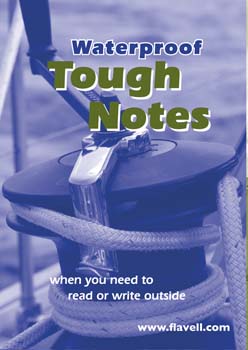

With all of these options, here’s hoping your attempts to keep your wet-weather documentation organized will meet with smooth sailing.
Paper Doll Organizing Carnival: Winter 2012 Edition
Welcome to the Winter 2012 edition of the Paper Doll Organizing Carnival! As I mentioned back in September, this periodic series will give us a chance to discuss some of the more quixotic and delightful items related to paper and organizing.
PAPER DOLL’S PAPER DOLLS
In The Sentimental Stuff: A Photo or Portrait Can Sometimes Replace a Thing, the magnificent Jeri Dansky illustrates how one kind of paper — a photographic representation of an item — can preserve an emotional connection while setting the clutter free. In other words, take a picture — it’ll last longer!
Savvy Margaret Lukens knows Why GTD Isn’t Working for You. If your results from the Getting Things Done time management system are flagging, check in with Margaret’s insights and suggestions.
Rebecca Joines Schinsky isn’t a professional organizer, but her How to Say “I Do” to Shared Bookshelves Without Ruining Your Relationship in Book Riot is as masterful as it is funny.
THE BOOK NOOK
Although I love the fact that my Kindle lets me carry the world of Jane Austen around with me, it’s still rare to see me without a few dead trees in tow. As I write this blog post, I’m hankering to get back to the fascinating Selden Edwards’ The Little Book: A Novel.
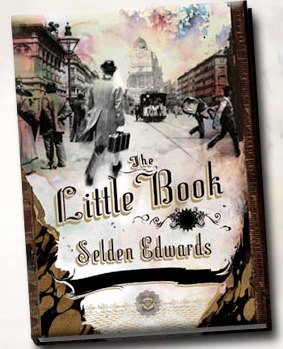
Spanning from 1897 Vienna coffeehouses to the infamous Altamont concert of 1969, with stops in World War II Germany and at Boston baseball diamonds, this time travel saga has romance, intrigue and political discourse, transfixing me in a way that I’m not sure a digital reading could have achieved. Some stories require the turning of actual pages.
One advantage that digital books have over paper is that you can create your own annotations without harming an actual book. Anyone who has sighed with dismay over an excellent volume ruined with the cramped scribblings of a prior reader knows that writing in a book is just plain villainy.
Reading Notes is an intriguing alternative to defacing your books. They’re perfect for those of us who lend books and want to share our comments and thoughts, and for anyone who likes to keep track of quotations for future reference or ideas for blog posts or wedding toasts.
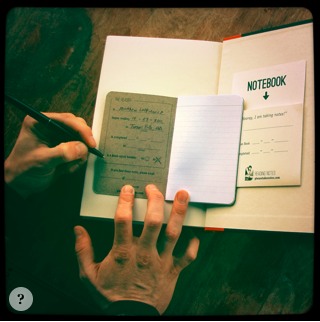
Reading Notes has a particularly non-21st century feel, and I mean that in the best way. When you acquire a book, just affix an envelope pocket to an interior page or cover of the book. Then, as necessary, dash off pertinent comments (the dates you started and finished the book, page numbers of favorite lines, drafts of a love letter or first chapter of a Great American Novel inspired by the book, etc.). When you’re done, tuck the little notebook into the envelope to review in the future, or share with readers to whom you lend the book, allowing them to share comments as well.
This appears to be a little labor of love for Matthew Latkiewicz, who also writes about wine, creativity, and productivity, and whose side venture is creating comedic “fake audio walking tours of real places.” Matt prices the Reading Notes at $15.95 for a package of three notebooks.
Speaking of booklending, Paper Doll is a sucker for just about any kind of bookplates that ensure safe return of a title to one’s library. As such, I wanted to share these retro personalized library card/sticker sets from Etsy shop Littlebeane Boutique. Each set, at $7.95, includes twelve 2″ x 3.5″ vertical rectanglular stickers on high quality matte paper stock.

STUCK ON YOU
By now, readers have a sense of my initially-strong antipathy for floozies, but I think I’ve shown that I’m not afraid to flip-flop when my perspective has been expanded. In that vein, I do love the Jumbo StickIt Pad from the wacky folks at Vat19.com.
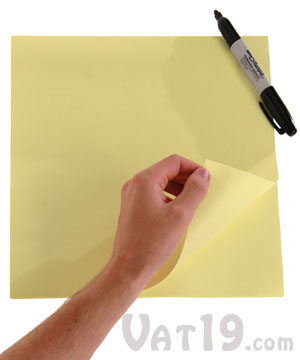
When it’s hard to motivate yourself towards productivity in the dark drear of winter, Dr. Paper Doll prescribes color, and lots of it. Happily, 3M obliges with eight fresh new palettes in the Post-It Color Collection: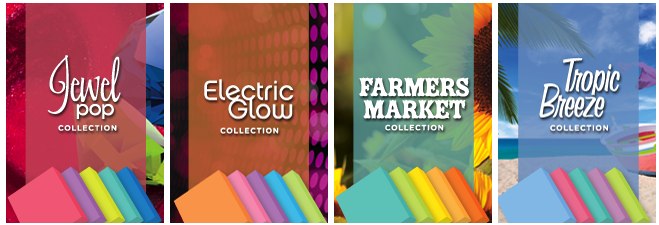
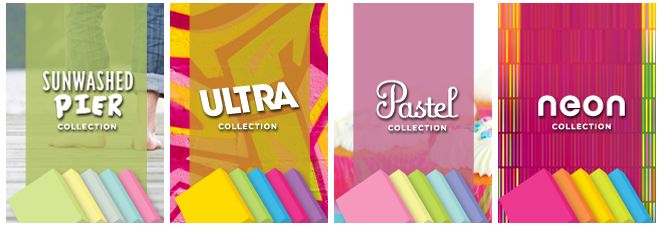
In addition to traditional cubes and pads, the products available differ by each collection; for example, Sunwashed Pier includes a variety of Post-It recycled Greener notes, while Electric Glow sports a wide variety of SuperSticky notes and Tropical Breeze has recycled SuperSticky notes. Visit the site to take a quiz to determine your color personality and be sure to click to get a $2 off coupon.
A MEMORABLE BURST OF COLOR
The lovely blog All Things Paper just shared a profile of Julie VonDerVellen‘s amazing garment “replicas” made entirely of paper. VonDerVellen’s artist statement explains that these are not merely paper renderings of outfits, but a mixing of memoir and storytelling — “recollection tailored narratives” — generated from paper craft creations made from recycled cotton clothing. And they are stunning. I still can’t get over the dress associated with the tale of Christine B.’s The Great Prom Saga.

2012 Julie VanDerVellen
THE MAGIC OF WORDS ON PAPER
From Siri to podcasts, it’s true that we can get more information than ever before without reading it. But reading, as opposed to listening or watching, is the only way we can actively consume information and entertainment at our own pace, doubling-back or skipping ahead at our convenience and our leisure. Only when reading do we supply all of the essentials for complete surrender to a story, and ironically, that surrender empowers us. While few would doubt that Colin Firth is the perfect Darcy, I think the powers of our imagination in drawing characters and situations (from the classics to sparkly vampires and girls with dragon tattoos) usually surpass anything that can be fed to us by the media.
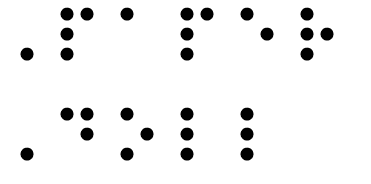
Did you know that January has been Braille Literacy Month? When it comes to paper, we tend to think of what we have to do to maintain it — open the mail, pay the bills, file the documents, recycle the refuse, and so on. Especially with the ever-growing digital presence in our lives, we take the benefits of paper for granted. However, I have been fascinated by reading 15 Facts to Share During Braille Literacy Month, and have a newfound appreciation for the independence and creative opportunities paper grants us.
THE FUTURE OF PAPER: REPORTS FROM THE FIELD
In many respects, the digital world is encroaching on what had previously been the province of paper. It’s hard to believe it’s been more than three years since Paper Doll asked, May I Have Your Card? and discussed the issue of organizing business cards. I wasn’t entirely a Luddite. It’s not that the post ignored the issue of digitizing, but it certainly presupposed that we were, at least initially, dealing with a business card — a piece of heavy card stock with carefully considered font selections and design choices.
Now, however, the discussion has to include the likelihood of a future with no business cards at all. American Express’ Open Forum raises points on the issue with Is It Time To Finally Ditch Your Paper Business Card?
As a professional organizer, I appreciate the notion of streamlining data, but just as I mourn the loss of album cover art displayed to its full advantage, I know that someday I’ll miss spotting my signature color-scheme card in a fishbowl or feeling the frisson of anticipation when I trade crisp cards with someone and sense that it could be “…the beginning of a beautiful friendship.”

As a professional organizer, I’ve guided you towards getting rid of junk mail and digitizing more of your finance-related paper, but what about paper that you might actually want? While business turns away from paper, literature is embracing it in new ways. The literary blog The Rumpus had started an enchanting Letters In The Mail project.
For a $5 monthly subscription price, or $60/year, subscribers will get a weekly mailing (with a stamp and everything!) of innovatively conceived and creatively written letters from novelists, memoirists, comedians, and other literary types, including Dave Eggers, Marc Maron, Emily Gould, Tao Lin and Rumpus editor Stephen Elliott, who started the project to “rekindle the pleasures of paper correspondence,” according to the blog Book Riot.
Organizing literature on loose pieces of paper, instead of digitally or even in bound books, may fly in the face of traditional organizing practices. But I believe that organizing isn’t about stuff. It’s about how we interact with our stuff. As such, I believe that The Rumpus’ Letters in the Mail endeavor can foster some small measure of slowing down, organizing one’s time in such a way as to approach opening the mail as one might approach a fine meal, as opposed to fast food — with intention and an expectation of grace.
In a charmingly old-fashioned manner (which I imagine could turn problematic quickly), some authors will include their return addresses, making it possible for fans to reply. Imagine corresponding with the next Austen or Dickens or Hemingway! Wouldn’t the anticipation and eventual receipt of an actual paper letter be more thrilling than any delivery of an email? More tantalizing than a text or Kindle download?
Speaking of writing, Paper Doll loves hearing from readers. Please share your thoughts on any of the above carnival attractions in the comments section, below. And don’t forget — there’s still time to enter the Paper Doll/ListPlanIt contest!
Paper Doll Shows You Some List Love and Throws A Contest With ListPlanIt
LIST LOVE
It’s a common practice that when you want to be productive, you make a list. A grocery list. A packing list. A to-do list. What’s a recipe except a list of ingredients followed by a list of tasks? What’s an instruction manual except an ordered list of behaviors for achieving the optimum outcome?
List-making has always been popular, even among celebrities whom you might think would have “people” for that. (Paper Doll likes to imagine that “Meet Paper Doll” is on George Clooney’s bucket list.) One of Johnny Cash’s intriguing lists has been making the rounds on the blogs:
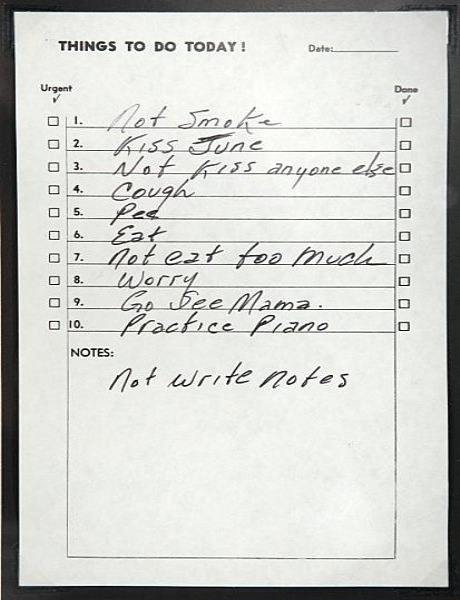
Novelist Umberto Eco has written philosophically about The Infinity of Lists and Liza Kurwin has captivated readers with Lists: To-dos, Illustrated Inventories, Collected Thoughts, and Other Artists’ Enumerations from the Collections of the Smithsonian Museum.
Lists are so central to the concept of organizing our intangibles — like time and tasks — that one of the first mnemonic devices I conceived as a professional organizer was List LOVE: Lists Organize Virtually Everything. Getting everything out of our heads and onto paper (or our digital screens) helps ensure that nothing will fall through the cracks.
The problem with creating our own lists, however, is that while we are experts on our own lives, we don’t always have perfect memories or full control over our creative thoughts. Creating a list ensures that we get everything we’ve thought about into more solid form, but what about things of which we haven’t conceived?
We make lists so we don’t forget anything, but surely we recognize that not every option is available to us on demand.
ENTER: LISTPLANIT!

ListPlanItis the five-year-old brainchild of Jennifer Tankersley. It’s a membership-based site designed for those who live for lists as well as those who need some help in figuring out what goes on which lists to make life easier to lead.
THE LIST OF LISTS
ListPlanIt offers up 700+ lists, browsable by topic — everything from business planning to time management, moving to travel planning, student living to holiday planning. Need a template for a sign-in sheet for your book club? It’s there! Want help putting together a budget for an anniversary party? Look no further. The following grid gives you an idea of the breadth of major categories.

Of course, those are only the main categories. Under Family Matters, there are sub-categories for Health and Safety, Responsibilities, Activities, Family Management, Baby and Pet. From the serious (medication trackers, babysitter instructions and chore charts) to the delightful (tracking visits from the tooth fairy), ListPlanIt anticipates a wide variety of listly needs. ListPlanIt offers elaborate, meticulous lists to help with the myriad tasks of parenting, from packing a hospital bag for labor to potty training to teen responsibility checklists.
Although many of the lists are designed for family use, ListPlanIt knows that we cannot (and do not) live by carpool alone. Under the Business Planning category, there are sub-categories for Management, Social Networking, Marketing and Finance, and under those umbrellas, lists abound to capture every detail of modern business life, from time sheets and blog post planners to mileage logs and budget worksheets.
Some issues bridge the work/life divide, like Time Management, so ListPlanIt offers up customizable daily, weekly and monthly planners, to-do lists and long-term goals charts. And money mavens Suze Orman, Jean Chatzky and Nanette Duffey would certainly be impressed with ListPlanIt’s profusion of Financial Management lists, from budgets and worksheets for funding goals to tax form managers and charitable records.
When ListPlanIt began in 2007, there were 200 lists. By the time Paper Doll gave it a brief review in 2009, that number had more than doubled, and new lists continue to appear. Recent debuts have included lists for attending conferences (budgeting, packing, preparing and scheduling), a craft inventory supply checklist, a comparison shopping list for supplies and many more.
And the lists go on.
MEMBERSHIP HAS ITS PRIVILEGES
ListPlanIt has three levels of membership, all of which guarantee members one year of full access to all lists (from any computer), without having to put up with pesky ads or pop-ups.
Lists and planning pages are generally in template form, and the type of membership determines how/whether the forms can be manipulated.
Personal/Family Print Memberships grant full access to all lists for $20/year. (For the budget conscious, that amounts to thirty-eight cents per week!) Members may print any of ListPlanIt’s lists as many times as they like. At this level, there are no downloads, and any manipulation, revisions or additions must be done by hand on the printed page.
Personal/Family Download Memberships grant the added ability of downloading forms and typing directly into them before using and/or printing. This option is more eco-friendly and is better for those, like Paper Doll, with dubious handwriting skills. The download membership is $30/year.
Professional Memberships are geared towards professional organizers and productivity professionals. For $50/year, professional organizers can use the lists to help their clients master the art of list-living.
All credit cards are accepted and processed through PayPal. Once you become a member, you’ll be able to log into your account and access your lists. ListPlanIt even has a guarantee of satisfaction.
CURIOSITY KILLED THE CAT…BUT SATISFACTION BROUGHT IT BACK
Are you curious but not ready to try? To get a feel for what ListPlanIt is all about, you can access a handful of sample lists at the trial page.
LISTING SOME BONUSES
Whether you’re a member or still checking things out, ListPlanIt offers up a hearty spate of resources, including:
- The L.I.S.T., a weekly opt-in email newsletter, filled with tips, sample lists, links and resources for a more organized life
- An articles page, rich with guidance on topics from preparing your child for school to building a better budget
- Jennifer Tankersley’s famous List Mama blog offers up timely and timeless posts to augment your knowledge and share a bit of the list life
- A growing series of video tutorials for maximizing the benefits of various lists and planners
- An online directory of professional organizers who are also ListPlanIt members, for those who would like a little extra guidance in optimizing their use of lists
SUPERSIZING YOUR LISTS
Individual lists serve specific, disparate purposes, but ListPlanIt has taken it a step beyond with a series of ePlanners — type-enabled PDF versions of whole ListPlanIt categories and planning pages. The ePlanners are immediately downloadable, so there’s no waiting, no shipping costs, and no need to print unless you want to. Just type your revisions right into the PDF and save for future use or reference.
Each individual ePlanner is $7, and ListPlanIt offers ePlanners for the following categories:
- Baby
- Birthday
- Club
- Contacts
- Family
- Financial
- Holiday
- Home
- Meals
- Memory
- Moving
- Personal
- Planner
- School Memories
- Student
- Travel
THE CONTEST
Paper Doll has partnered with ListPlanIt for not one — but TWO — giveaways. We’ll be giving away one ListPlanIt print membership (value: $20) and one ePlanner (value: $7). Here’s a list of what you need to know to enter:
1) Tweet and/or Facebook–post about this contest with the hashtags #PaperDoll and #ListPlanIt, and include a link to this post.
2) Use the comment section below to share what kinds of lists you like to make.
3) Tell us which ListPlanIt ePlanner you want the most, and why.
4) Note your Twitter ID or Facebook profile in the body of your submission comment. (Note: OnlineOrganizing’s blog system doesn’t allow clickable links in the comments, so remove the http:// from any link you provide.)
The deadline for submissions is Monday, February 6, 2012 at Noon, EST. Two winners will be chosen randomly and announced in early February.
Good luck, and happy listing!
Paper Doll Cuts Coupon Clutter
The issue of expired coupons in last week’s post prompted a flurry of reader email. It’s time to admit why Paper Doll has generally avoided blogging about coupons. It’s certainly not because I fail to appreciate bargains. My reticence has more to do with what I see as the Coupon-Industrial Complex.
GOING TO EXTREMES
Whole web sites are devoted to an increasingly complex series of coupon-related grocery store challenges, and TLC has elevated Extreme Couponing to a national sport. I applaud those who navigate the systems to save money and inexpensively acquire bulk items they then donate to charity. However, in many households, frenzied couponing yields large quantities of unneeded items and those that expire or perish before they can reasonably be used. Extremely organized participants can warehouse mass purchases, but too often, mass couponing results in massive, unmanageable clutter.
In a recent issue of her newsletter, The Dotted Line, Amy Bergin, founder of The Couponizer (of which, more later) examined her plight as a more temperate, moderate couponer and noted with insight,
Sure, devoting more time (that I could be doing other things) and increasing the volume of coupons (that require more time to manage) used will increase my overall savings, but I also factor in the quality of my purchases and the quality of the life I have created for myself and my family as a result of my spending to decide if all this is worth the effort.
Extreme couponing requires diligence, a particular kind of lifestyle and flexible family food preferences. It may very well be worth it financially, but it isn’t easy. And in an age where people feel overwhelmed by so many demands of modern life, disorganization often goes hand-in-hand with self-recriminations over unmaintained systems.
Thus, today’s post isn’t for extreme couponers. If that’s your area of interest, I suggest:
The Grocery Game — Terri Gault provides a system and database for accessing coupons, comparing prices and identifying when to make purchases for maximum benefit. There’s a one-month free trial, after which membership is subscription-based.
The Drugstore Game seems even more complex. As I read the arcane rules and combinations, my grip on comprehension echoes long-forgotten calculus lessons. For a primer, I direct you to blog posts from Money Saving Mom, Chief Family Officer, and Family Friendly Frugality.
Be CentsAble, created by Chrissy Pate, is a testament to the variety of ways one can use coupons, coupon databases and shopping systems to save money. Chrissy and co-author Kristin McKee wrote Be CentsAble: How to Cut Your Household Budget In Half, which is chock-full of superior non-nonsense consumer advice.
For the rest of you who hope to save some money on your everyday purchases without becoming Edward or Edwina Scissorhands, let’s explore basic couponing tips.
CLIP CLIPPING BEFORE IT GETS OUT OF HAND
As you approach clipping coupons, be realistic, and be honest with yourself.
Only clip coupons for products you:
- Already actually use, or
- Are willing to try and
- Are likely to try
Many coupon and shopping bloggers advise: “Don’t be brand-specific” or “Don’t just clip the coupons you think you might use.” That may work for the extreme shoppers, the ones willing to collect and hold onto ten weeks’ of newspaper inserts, check databases to identify the timing of specials, and create shopping lists based on an algorithm of sales, coupons and warehousing/shopping cycles.
Paper Doll has no doubt that these kinds of systems work for people who have the time and the inclination to invest in these efforts. However, as most consumers find, this isn’t a process to which the typical consumer can commit.
First of all, many of us have brand-specific tastes. The only orange juice I find palatable is Minute Maid Pulp-Free from concentrate. Choosy mothers choose Jif, but Paper Doll picks Peter Pan. Many you probably find that your family members have the same picky, child-like palate as I have, and you’ve come to be realistic about how much food flexibility your family will embrace.
I’m not saying you shouldn’t experiment with groceries or household items. After all, you might find that a generic detergent cleans just as well as a name-brand and is less expensive than the brand product, even with a coupon and an advertised sale. But again, be realistic.
If your culinary repertoire includes only seven recipes, all pasta-based, it’s unlikely that you’ll take advantage of coupons for exotic foodstuffs you’ve never eaten, let alone prepared. If a coupon entices you to try something new, that’s fabulous. But don’t clip coupons with the expectation that you’ll make wholesale life changes based on retail behavior.
What about buying in bulk? The grocery bloggers are, in the abstract, correct. Stock up on items purchased on sale and via coupons, but know your limits. If you live in an apartment, you probably can’t store 96 rolls of toilet paper. There’s a square inch limit to how much of even the most delicious deeply-discounted ice cream you can accommodate in a fridge-top freezer.
STORING COUPONS & COUPONING AT THE STORE
One of the rubrics of organizing is that if a system is too complicated, or a storage area too hard to access, you’ll find excuses not to use it. Keep It Simple, Silly!
Centralize coupons within one accessible, portable solution.
Casual Couponers
If you’re generally going to use fewer than a dozen coupons over the course of a few weeks, neatly arrange them with the soonest-to-expire on top, paper clip them together, and tuck them in your wallet, directly behind the currency. Don’t worry about sorting. It will take only a matter of seconds, while at the store, to flip through your coupons so that you can make sure you buy something for which you have a coupon.
Cent-sational Couponers
If your coupon use is light-to-moderate, you don’t need luxury level coupon storage. A simple checkbook-sized accordion folder like the five-pocket Smead Tag Along will suffice.

The purse-size Deluxe Coupon Organizer Wallet, available in a variety of patterns, works well for those who prefer a little style along with their substance.

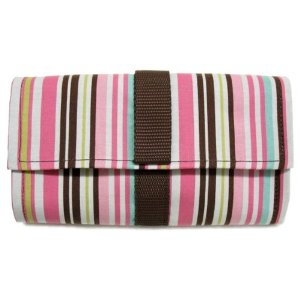
When open, it straps directly to the grocery cart for easy access while shopping.
Consider simple categories like groceries, toiletries, cleaning supplies, pet/specialty items, etc. and sort coupons into general chronological order by expiration date. Don’t get too caught up — “this week”, “soon”, and “not for a while” will suffice, or you can charge your kids with the job of organizing by strict expiration chronology, if you need to keep them busy and quiet.
Before you head for the store, flip through each category to see what you might want to add to your grocery list based on soon-to-expire coupons.
Carload Couponers
If you’ve got a family or are otherwise shopping for multiple people, you’ll obviously have need for a more expansive (and expandable) system for keeping your coupons organized into myriad essential categories. The more coupons you corral, the harder it can be to maintain them neatly and still be safely mobile.

The standard-bearer in this arena is a professional organizer favorite, Amy Bergin’s The Couponizer, a system for gathering coupons, sorting them, and housing them safely within the Couponizer book.

A full Couponizer system includes a variety of tools, including 18 category pockets for various food and merchandise types, loyalty sleeves (for safeguarding store loyalty cards, “punch” cards and gift cards), the CoupStacker expandable coupon sorting mat, the CoupTracker for tracking progressive savings, a shopping list, scissors and a carrying case.
DIGITIZING COUPONS
Newspaper inserts and magazine coupons are fine if you already take the paper or subscribe to coupon-filled magazines, but consider how technology can advance your couponing strategies without increasing paper clutter.
First, there are a variety of sites from which you can select and print manufacturers’ coupons. Check the sites and Facebook pages of your favorite products, and review the following sites from which you can print just the coupons you want:
Be CentsAble
Cool Savings
Coupons.com
Mambo Sprouts (for organic groceries)
RedPlum
Smart Source
Paper Doll is also a huge fan of Lori Felix’s blog More With Less Today, which links to a wide variety of printable coupons, discounts, retail and travel deals, and freebies.
In addition, there are options for bypassing paper coupons altogether.

SavingStar is a free web site that provides no-clip coupons. Search by zip code to locate grocery stores and drugstores convenient to you and then register your loyalty card numbers with SavingStar. At your leisure, log into the site, select the coupons you wish to redeem, and they are digitally loaded onto your card. When you make a purchase using your loyalty card, instead of the coupon being redeemed in cash as cents-off, the amount accumulates in your SavingStar account until you decide to cash out via check, deposit the money in your Paypal account or donate your savings to charity.

Cellfire is a free service that helps you locate, select and store digital grocery coupons on your store loyalty card and non-grocery discounts on your smart phone. Discounts stored on your loyalty card are automatically deducted when you use your card while shopping; to get the discounts from your phone, just show the mobile coupon to the cashier. Cellfire also offers printable coupons, which you can have sent to your computer to store for later printing.

ShortCuts provides free access to digital coupons. Sign up for an account, register your loyalty cards, and at your convenience, click on the coupons you want loaded onto your card. Coupon discounts will be automatically deducted when you swipe your card at the store. As with Cellfire, you can also select and send printable coupons to your computer.
Whether you’re old school or high tech, single-serving or family pack, there’s a way to keep your coupons organized and under control…without going to extremes.
Happy Get Organized Month — Baby Steps for Getting Started
Happy New Year, Paper Doll readers!
January is designated National Get Organized Month. To help you get started on the road to organization without causing the old January Gym Membership Effect, today’s post gives you tiny, easily-digestible tips for achieving organization without pulling any muscles or becoming overwhelmed.
SHOW 2011 PAPERS TO THE EXIT
Holding on to paper you don’t need builds clutter. Go from room-to-room, zone-to-zone, purse-to-bookbag and isolate the paper that’s just weighing you down:
Expired Coupons — You receive no financial benefit from expired coupons. If you’re keeping them to remind you to purchase something, start a real shopping list, instead.
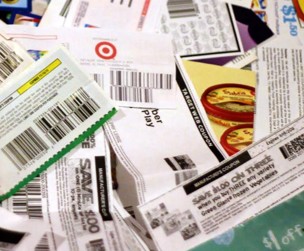
If you want to release yourself from the mildly anxious feeling that you shouldn’t have been schlepping the coupons around all this time, unused, do a good deed with them. Military families living on-base can use manufacturer’s coupons (i.e., not store-specific ones) at their commissaries/PXs for up to six months after the expiration date. So pop them in an envelope and send them off via guidance from:
Coupons to Troops
Troupons
Overseas Coupon Program
GrocerySavingTips.com
or check with your local American Legion Auxiliary chapter to see if they collect, package and ship coupons to military bases. [Canadian readers: I’ve had trouble finding a similar program up north. Please share any information in the comments section, and I’ll add it to this post.]
Greeting Cards — The classic Paper Doll post, Hallmark Holidays and American Greetings: Card Clutter should give you the confidence to make the necessary decisions regarding which cards to recycle and which (few) to preserve. Cards lacking deep personalization or extreme entertainment value should go, but Card Memories’ Greeting Card Keeper Albums that we reviewed in 2010, offers a storage solution for those truly special sentiments.
Magazines and Newspapers — If they say 2011, they’re not news, they’re history. Knowledge is power, but information clutter is Kryptonite. It leaves you mired in piles, paralyzed and unable to act on the information because you can’t make dependable use of it.
If you didn’t get around to reading those holiday decorating tips or recipes, it’s OK. They’ll be back again in about ten months with only slightly altered graphics. Deliver magazine donations to shelters, clinics or hospice venues and toss the newspapers into your recycling bin. Make room for the future in your home and office by letting go of the past.
Floozies — Longtime Paper Doll readers know how I feel about floozies (loose, homeless paper scraps). All those bits and pieces represent potential utility, but as they are, it’s too hard to find the information you need when you need it. Floozies tend to congregate in certain areas — stuck to your computer, on or near your desk, in the kitchen and by the phone chargers. Be relentless in policing this vice, gather those floozies and take them off to the hoosegow (or, y’know, a clear surface, like the dining table).
Start separating your sticky notes and scraps into categories, and once grouped, find alternative ways to keep the information but toss the paper:
- Passwords — Transfer them to a password notebook like the Internet Password Organizer (now in paperback) or use a password management program, like LastPass, KeePass or Mitto.
- Phone numbers and addresses — Don’t depend on your memory of where you stuck someone’s number or address. Add the contact information to your phone, computer or Snoopy address book. As with calendars, the key is to commit to a system, any system, and stick with it.
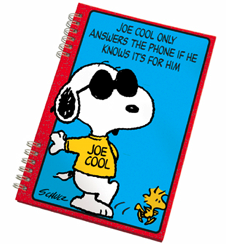
- Things you want to buy — If you’re old school like me and prefer paper, get yourself a cute little assignment notebook or Moleskine. Otherwise, pick your favorite app (Remember the Milk, Grocery Gadget, etc.) to ensure that you’ll know what you need to acquire when you’re in a position (and location) to acquire it.
- Books or movies you want to check out — Your Amazon wish list or Netflix queue is perfect for reminding you of media that’s worth another look, even if you eventually borrow the items from your public library.
- Web sites you want to explore — Use Bookmarks or Favorites, so they’re available when you are. Afraid you’ll forget about them (as if a half-destroyed Post-It sitting under a coffee cup from last Friday is going to remind you)? Set an alarm on your computer for a particular time each week to remind you to peruse your recently-collected sites; purge the ones that fail to live up to the hype, and organize the worthy ones in bookmark folders.
- Creative ideas — When the muse is active but you’re busy doing other things, it’s natural to grab for the nearest piece of paper to capture your brilliance. But deal with the backlog by sorting your brilliance into categories and then make up a plan for how you’ll incorporate the ideas into your endeavors. For my purposes, different notes might be suitable ideas for Paper Doll blog posts, references for Best Results for Busy People newsletter articles, notions for ebooks, and so on. Just keeping a separate folder for each major creative area of your life will corral the papers while preventing the loss of (potentially) staggering genius.
Have you got too many floozies, and not enough time to do more than group them? Or maybe you wish you could make them portable? Grab your camera, get shots of each category in a gridded, Pinterest fashion, and upload them to your computer for easy zoom-in access.
BECOME A (TAX) COLLECTOR
April 15th may seem far away now, but think how quickly the last three months have sped by. Take just a few minutes a day over the next week or so to make the road to tax season free of paper blizzards.
Call your pharmacy and request a printout of your prescription purchases for the previous year. This will give you a jump start on calculating whether you can deduct medical expenses when you do your taxes. You should be able to get your own printout and that of your children, but your spouse may have to request his/her own.
When you pick up the prescription purchase forms, just drop them in your tax prep folder. No tax prep folder, you say? That’s easily fixed.
Create tax prep folder(s) for 2011 items so that as soon as 1099s, W-2s and other tax forms start arriving in mid-to-late January, you’ll have someplace to put them. (Go ahead and make a folder for 2012, so there will be a place to put the tax-related receipts you collect throughout the coming year.)
If your financial life is simple, one folder may suffice, but if you’ve got complexity, consider separate folders for charitable donations, investment information, financial or real estate transactions, medical expenses and “miscellaneous taxable event” notes. Alternatively, use one of the Smead Tax Organizers we’ve reviewed previously.
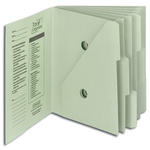
Take a peek at last year’s tax return (you know where it is, don’t you?) to make a list of the forms and notifications you should be expecting, and check them off as they arrive. If you’ve got newly acquired taxable assets, like stocks, add those to the list. These notes will help you figure out if any W-2s, 1099s or 1098s are missing. For more on what these forms represent, review the classic Paper Doll post on what goes into A Taxing Treasure Hunt.
TRAVEL THROUGH TIME
Visit the past — In One Last Flip Through The Calendar, we once examined how reviewing the lessons of the past could help make for a stellar future. Pop back in time to that post so you can revisit the lessons of the year gone by — the successes, surprises, opportunities, recurring events and missed connections — and put them to good use in building 2012.
Journey to the future — It’s impossible to organize your time without having a system for planning all of your obligations (and desired activities) and figuring out when you’re going to get around to them. “Someday” is simply not a day on the calendar.
If you haven’t figured out what kind of planner would rock your world (eliminating chaos and giving you back control), and if your visions were still full of sugar plums last week, be sure to catch up with Paper Doll Marks the Calendar for a Successful 2012.
Write the darn thank-you notes! The mental energy wasted on knowing you have to do it and procrastinating anyway keeps you from accomplishing so many of your other goals.
Grab some stationery or a box of note cards, your address book, and a roll of stamps. Take a deep breath and jump in: let the person know you got the gift, how you’re going to use it, how much you appreciate it, and then mail it off. It takes five minutes (at most) to write a thank-you note; don’t let your desk or kitchen table stay piled high with reminders throughout January when you can just do it now and be done.
Paper Doll knows how the first week of a new year can seem like a splash of cold water after the relative coziness of the holiday week, but the best way to warm up to a new calendar year is by easing yourself into organizing mode. Tackle one of these tasks or projects every day or so in the new year, and you’ll be feeling more organized in no time!





Follow Me